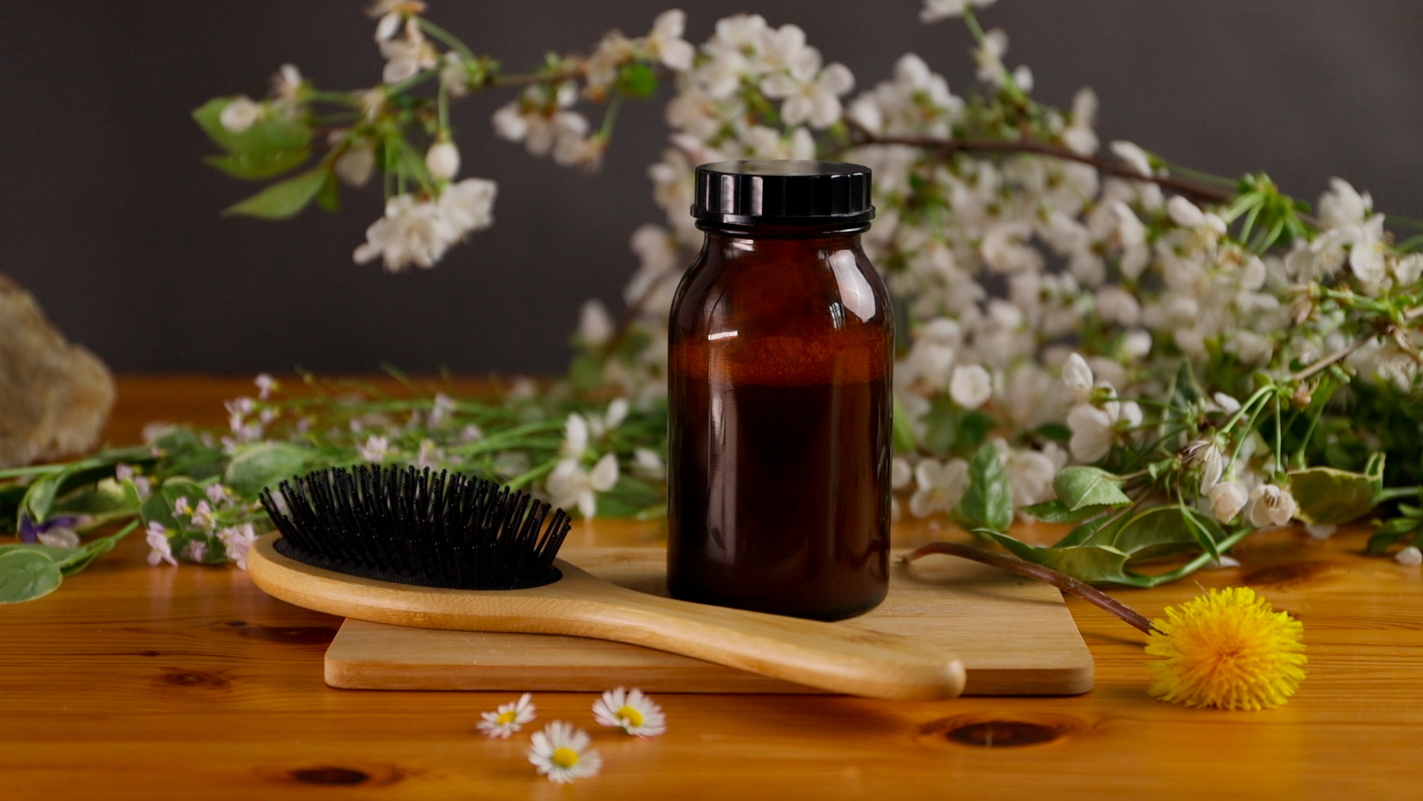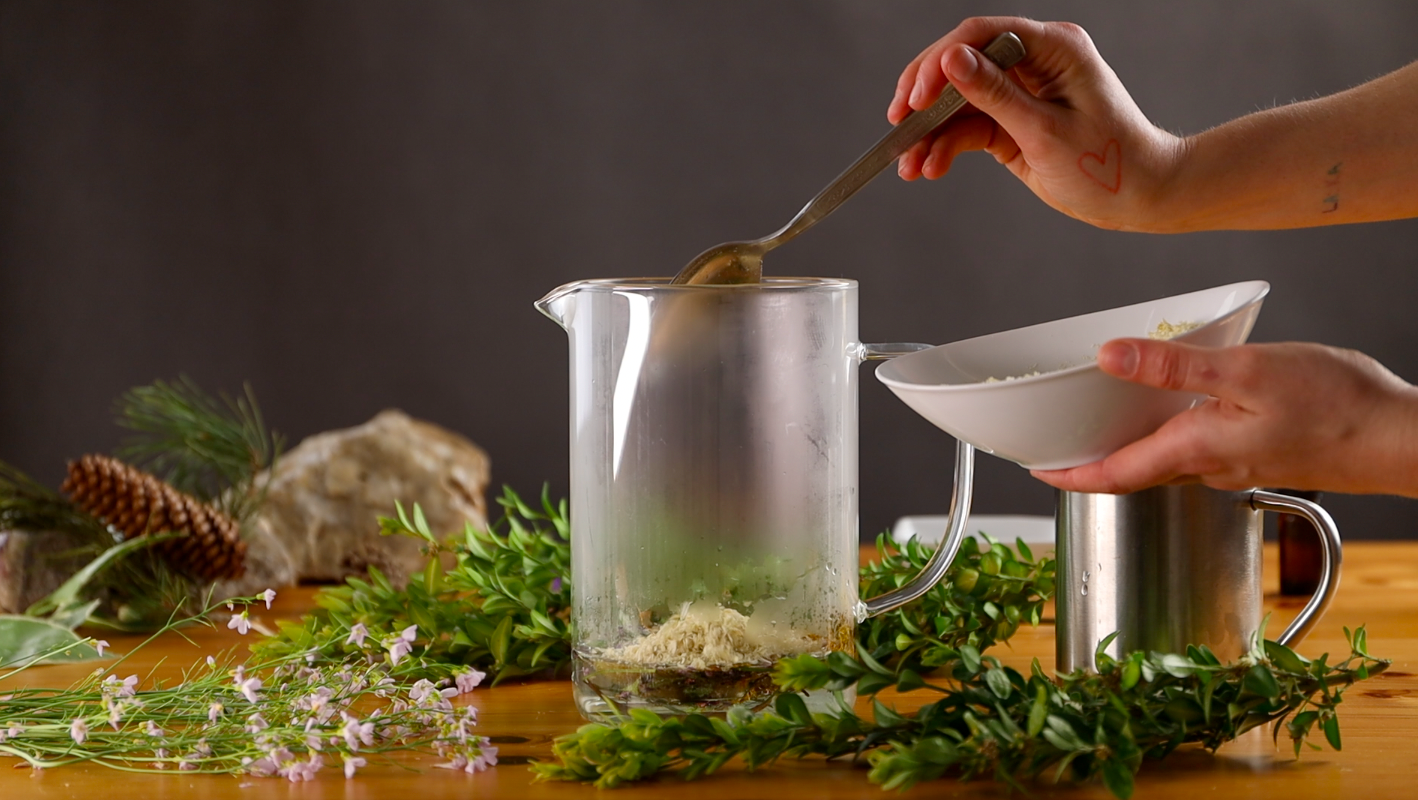Do you check the composition of shampoos in shops and avoid those containing the notorious parabens and silicones? What about the surfactants such as SLS (Sodium Lauryl Sulfate) and SLES (Sodium Laureth Sulfate)? Or oil, palm oil, artificial dyes, ethylene, or other possible substances like 1,4-dioxane, or triclosan, don’t you mind those?
Of course you do. If you want to avoid these aggressive ingredients, bet on natural-friendly remedies for which your body will be grateful. We have prepared a simple recipe for herbal shampoo for you, which you can also make with young children as part of your afternoon programme.

A rich foam? It can be done differently.
If you are one of the lovers of rich foam, you may change your mind. Sodium Lauryl Sulfate, a.k.a. SLS, takes care of the foaming in shampoos. It has great cleaning properties, it is cheap and works well against grease (it was originally invented as an industrial cleaner).
However, this SLS is absorbed through the skin into the bloodstream, damaging hair roots and irritating the eyes. In addition, as it degreases the scalp and removes moisture, it opens a “gateway” for any other harmful substances that similar shampoos also contain [1].
SLES is the second surfactant that you can find in shampoos (also in toothpaste, etc.). While it is less irritating to the skin and eyes than SLS, it is harder for the body to break down. On top of that, it is deposited in the liver. Household shampoos tend not to foam like industrially made ones, but it’s a small concession in comfort considering our health [1].
A step-by-step guide to your homemade herbal shampoo
Ingredients list:
- 5 tbsp of grated organic olive soap with a high proportion of olive oil
- 250 ml distilled water
- 3 drops of essential oil of your choice
- 1 handful of dried or fresh herbs of your choice
Preferably 1 glass container with a minimum capacity of 300 ml with a lid. Clean washed, of course.
To use or not to use preservatives?
If you don’t use preservatives, this homemade shampoo will last you about 1 week in the fridge. However, if you take your shampoo on holiday and do not have the opportunity to prepare another, preservatives are the solution, but how do we know which one to use? One option is Geogard®, an antibacterial and antifungal synthetic preservative directly approved for the preservation of organic cosmetics. However, if you want to bet on nature, good preservatives include tea tree, lavender or grapefruit oil or alcohol.

Choosing herbs for shampoo according to their commonly known effects and hair type:
Nettle, dandelion: strengthening and growth
Elderberry, lemon balm: oily hair
Peppermint: itchy scalp
Garden parsley, field horsetail: dandruff, hair loss
Chamomile, marigold blossom, dense flower mullein: blonde hair and sensitive skin
Rose petals: shiny hair
Our recommendation: It is good to mix in essential oil in accordance with the aroma of the used herb. For example, you amplify peppermint with mint essential oil, as well as garden parsley and such.
Instructions for preparation:
- Boil the distilled water in a stainless steel (enamel) cup. The resulting volume should be 250 ml.
- Stir in a handful of herbs and 5 levelled tablespoons of grated organic olive soap into the still-hot water. Mix thoroughly.
- Once the mixture has cooled, add three drops of the chosen essential oil.
- It is advisable to let the shampoo ingredients steep for 24 hours.
- Drain the liquid over a cloth, or a fine sieve.
- Add preservatives at your discretion.
- Now just pour the handmade shampoo into the glass container, and label it with the name and date of production.
For beautifully glossy hair and a healthy scalp, a rinse of 1 part cider vinegar and 1 part water is ideal.
Our recommendation: The type of herb you intend to add to the shampoo and the essential oil, must be specifically selected. If you don’t know how your skin will react to a particular herb or oil, try them on a small piece of skin first. You’ll find out if you’re allergic to them or not.
GS tip: Despite the fact that this shampoo does not foam at all, the hair is soft and clean after washing. Although it is more suitable for dry or damaged hair. Or you can simply try it. I like to change products. So sometimes I’ll use this shampoo and the next wash I’ll use a cube of dry shampoo or wash with just baking soda – about a tablespoon of baking soda dissolved in a cup of warm water. Pour it on your head, massage a bit and rinse thoroughly.

Rinse from linden blossoms for healthy skin and hair
If you have dry and brittle hair or an irritated scalp, a linden blossom will help. Both dried and fresh. You’ll need 4 full handfuls of it.
Instructions for preparation:
Bring 1 litre of water to boil in a pot. Add 4 handfuls of linden blossom and simmer on low heat for about 30 minutes. Once cooked, allow the liquid to cool and use it cold. Hair should be rinsed twice a week after washing. Always prepare a fresh batch every time you want to rinse your hair.
Herbal rinses are a great substitute for industrially produced conditioners. Similarly, you can prepare a hair rinse from nettle, chamomile, or rosemary. You just need to be careful with very fair hair, as some herbs could cause it to discolour.

0 Comments